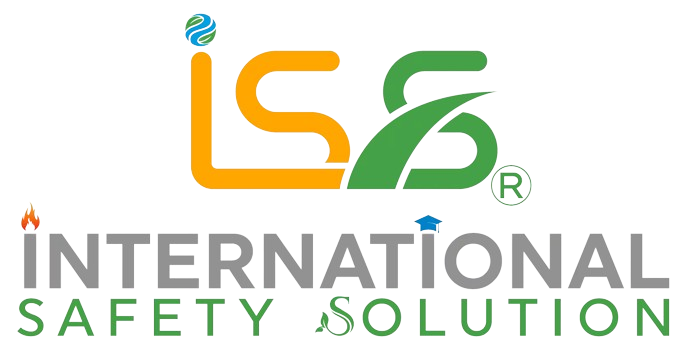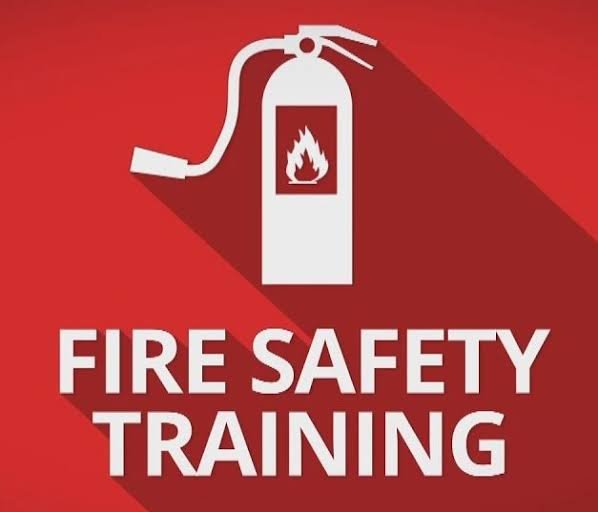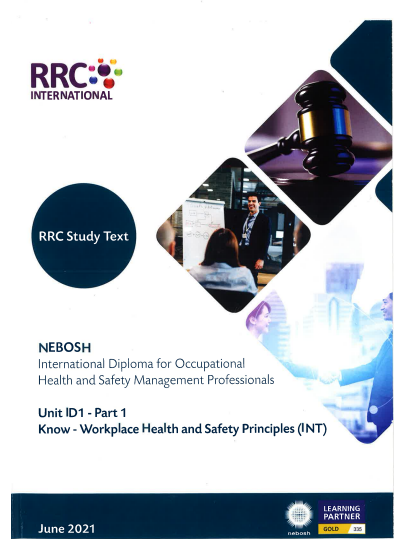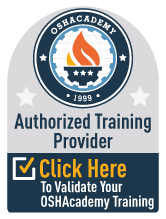NEBOSH IGC Question Paper (17 January 2023)
Discover the newest NEBOSH past paper in our blog, a crucial asset for excelling in occupational health and safety exams. Elevate your preparation with the latest official material. To view Nebosh past paperhttp://Discover the newest NEBOSH past paper in our blog, a crucial asset for excelling in occupational health and safety exams. Elevate your preparation with the latest official material. To view Nebosh past paper,file:///C:/Users/IS%20Solutions/AppData/Local/Microsoft/Windows/INetCache/IE/G40CJ2KL/IG1-0034-ENG-OBE-QP-V1[1].pdf
Task 1: Negative health and safety culture
Question 1
Negative health and safety culture can be observed in Zone 3 of the airport, influenced
by peers. Here are 14 bullet points highlighting these influences:
Informal Hierarchy:
The informal hierarchy within the team, where longer-serving workers feel justified in giving orders to newer or younger workers, creates an environment where safety concerns might not be openly addressed.
Worker C’s Authority:
Worker C, acting as an unofficial deputy for the supervisor, exercises authority over newer workers like Worker B, potentially discouraging open communication about safety concerns.
Task Allocation:
Worker C assigns Worker B to a distribution point alone, handling a large volume of baggage typically requiring multiple workers. This decision may prioritize efficiency over safety.
Peer Pressure:
Worker B faces ridicule from peers for questioning the task allocation, contributing to a culture where raising safety concerns is met with resistance or mockery.
Laughing and Pointing:
Peers openly laughing at Worker B and suggesting they “accept” their situation implies a lack of empathy and camaraderie within the team.
Approval-seeking Behavior:
Worker B, keen to fit in, refrains from raising safety concerns again, indicating a culture where conformity is valued over expressing concerns.
Supervisor’s Response:
Worker C’s dismissive response to Worker B’s concerns fosters an environment where challenging decisions may be perceived as insubordination.
Overlooking Daily Announcements:
Worker C overlooks reading out the daily announcements, including critical information about the contractor’s presence, contributing to a lack of awareness among workers.
Speed of Task Completion:
The high-pressure environment to efficiently complete tasks may lead to workers like Worker B compromising safety by rushing through their responsibilities.
Failure to Address Near Misses:
The increase in near misses over the past year suggests a lack of emphasis on learning from incidents to improve safety practices.
Peer-driven Conformity:
The laughter and mockery directed at Worker B imply a culture where conformity to the status quo is prioritized over questioning or improving safety procedures.
Lack of Reporting Culture:
Worker C’s threat to report Worker B for expressing safety concerns discourages open reporting, hindering the identification and resolution of potential hazards.
Inadequate Training:
The absence of specific safety training or protocols for handling large flights at distribution points may contribute to a lack of awareness among workers about potential risks.
Supervisor’s Absence:
The supervisor’s absence during the critical period of the conveyor repair and task allocation allows negative influences to go unchecked, contributing to a lax attitude towards safety. In total, these factors illustrate a negative health and safety culture in Zone 3, shaped by peer interactions and organizational practices
Task 2: Managing the contractor on site
Question 2
Managing the contractor on site are given below
Lack of Site Familiarity:
The supervisor assumed the contractor’s experience in zone 1 was sufficient for zone 3, neglecting the fact that the layouts might differ, indicating poor management in ensuring the contractor’s familiarity with the specific work environment.
Limited Introduction and Guidance:
The supervisor did not provide a thorough introduction to zone 3’s layout, equipment, or
processes, showing a lack of proactive management in ensuring the contractor had all
the necessary information for a safe and effective repair.
Absence of Supervision during Repair:
After a brief tour, the supervisor left the contractor to work independently, demonstrating poor oversight and management in not ensuring continuous supervision during the repair process.
Failure to Confirm Understanding:
The supervisor did not confirm whether the contractor understood the specific nuances of zone 3, indicating a lack of effective communication and management in ensuring the contractor’s comprehension of the work environment.
Inadequate Communication Channels:
The supervisor did not establish clear communication channels, such as providing contact details or a designated meeting point, contributing to poor management when the contractor needed assistance.
Delay in Checking Progress:
The supervisor did not check on the contractor’s progress promptly, leaving the contractor to seek help from other workers, showcasing a lack of proactive management in monitoring the repair situation.
Insufficient Emergency Preparedness:
When the contractor could not find the supervisor, there was no predetermined plan for the contractor to follow in case of difficulties, highlighting poor management in emergency preparedness and response.
Incomplete Handover:
The supervisor did not ensure a proper handover or direct the contractor to the distribution area whhere they would be available, indicating a lack of attention to details and a poorly managed transition.
Failure to Coordinate with Team:
The supervisor did not coordinate with the ALAs or communicate the contractor’s presence adequately, leading to confusion among workers and exemplifying a lack of management in ensuring a seamless collaboration between contractor and team.
Inadequate Post-Repair Communication:
The supervisor did not specify where the contractor should report after completing the repair, contributing to a lack of clear post-repair management and potentially delaying the resolution of any issues that arose during the repair process
Task 3: Actions of a labour inspector
Question 3 (a)
Actions of a labour inspector
Ensure Legal Compliance:
Labour inspectors verify that workplaces adhere to labor laws and regulations, ensuring that employers comply with established standards related to employment conditions, wages, and working hours.
Promote Occupational Health and Safety:
Labour inspectors play a crucial role in assessing and promoting workplace safety by evaluating the implementation of safety measures, identifying hazards, and ensuring employers take corrective actions to protect workers from accidents and occupational
illnesses.
Enforce Workers’ Rights:
Labour inspection involves monitoring and enforcing the rights of workers, including fair wages, proper working conditions, and reasonable working hours. Inspectors aim to ensure that employees are treated fairly and have access to their legal entitlements.
Facilitate Social Dialogue:
Labour inspectors promote communication and understanding between employers and workers. By fostering social dialogue, they contribute to the resolution of disputes, improving working relationships, and creating a more harmonious work environment.
Educate and Advise:
Labour inspectors provide guidance and education to employers and workers on legal requirements and best practices. They offer advice on how to improve working conditions, enhance safety measures, and address any issues identified during inspections, contributing to continuous improvement in workplace standards.
Question 3 (b)
Action that inspector should follow
Investigate the Incident:
The labour inspector would conduct a thorough investigation into the workplace injury, examining the circumstances, causes, and contributing factors. This may involve reviewing incident reports, interviewing witnesses, and inspecting relevant documentation.
Assess Compliance with Safety Regulations:
The inspector would evaluate the workplace’s adherence to safety regulations and standards. This includes reviewing safety protocols, training records, and the effectiveness of safety measures in place to prevent similar incidents.
Review Documentation:
The inspector would scrutinize documentation related to health and safety practices, employee training, and incident reporting. This helps assess the accuracy of record keeping and whether the employer has fulfilled their legal obligations in maintaining a safe work environment.
Interview Workers and Management:
The inspector may conduct interviews with both workers and management to gather insights into the incident, workplace safety culture, and the effectiveness of communication and training programs. This helps in understanding the perspectives of those directly involved and those responsible for safety oversight.
Task 4: Safety signage
Question 4
Safety Signages ;
Pedestrian Crossing Signs:
Brightly marked crosswalks with clear signage indicating designated areas for pedestrians to cross roadways, helping prevent accidents between workers, passengers, and vehicles. Roadway Direction Signs: Clear directional signs with arrows and symbols guiding vehicles along marked roadways, minimizing the risk of collisions and ensuring a smooth
flow of traffic.
Speed Limit Signs:
Visible speed limit signs for tow trucks and other vehicles in distribution and loading areas, promoting safe driving practices and reducing the risk of accidents due to excessive speed.
Caution Signs at Intersection Points:
Warning signs with symbols or text highlighting intersections between roadways and pedestrian routes, alerting both workers and passengers to exercise caution at these points.
Emergency Exit Signs:
Clearly marked emergency exit signs in indoor distribution areas, ensuring that workers and passengers can easily locate exits in case of emergencies.
No Entry Signs: Signs indicating restricted or no-entry zones for unauthorized personnel, preventing non-workers and passengers from entering potentially hazardous areas.
Loading Zone Safety Signs:
Signs specifying safety protocols for loading zones, such as instructions for securing baggage, using personal protective equipment (PPE), and maintaining safe distances from moving vehicles.
Hazardous Materials Signs:
If applicable, signs indicating areas where hazardous materials are handled, stored, or transported, with relevant symbols and warnings for workers and emergency responders.
First Aid Station Signs:
Clearly marked signs directing individuals to first aid stations, providing immediate access to medical assistance in case of injuries or emergencies.
Fire Exit Signs:
Signs indicating the location of fire exits and evacuation routes, ensuring that workers and passengers can quickly and safely exit the building during emergencies.
Task 5: Identification of management failures following root cause investigation and immediate actions to take following the accident
Question 5 (a)
Immediate actions to follow Immediate Review of Safety Procedures:
Discuss the necessity of an urgent review of safety protocols and procedures related to the operation of tow trucks, baggage loading, and overall distribution area activities.
Temporary Work Procedure Changes:
Consider implementing temporary changes in work procedures, such as increased oversight during high-pressure periods, until a comprehensive review and update of safety measures can be completed.
Reinforcement of Speed Limits:
Emphasize the strict adherence to speed limits for tow trucks and other vehicles within the distribution and loading areas to prevent accidents caused by excessive speed.
Enhanced Communication Protocols:
Reinforce the importance of clear communication between workers, including the need for immediate reporting of equipment faults or concerns about safety procedures.
Immediate Training and Re-Education:
Schedule urgent training sessions to refresh workers on safety procedures, emergency protocols, and the proper operation of equipment, focusing on areas identified as contributing to the recent accident.
Introduction of Additional Safety Signage:
Propose the immediate installation of additional safety signs, warnings, or visual cues in high-risk areas to enhance awareness and reduce the likelihood of similar incidents.
Increased Supervision During Repairs:
Discuss the need for heightened supervision and coordination during repair activities, ensuring that contractors and workers are adequately guided and supported throughout the process.
Employee Support and Counseling:
Address the emotional impact of the accident on workers, offering immediate access to counseling services or support programs to help them cope with any stress, anxiety, or trauma resulting from the incident
Question 5 (b)
management failures;
Inadequate Training and Supervision:
Failure to ensure that Worker B, a relatively new employee, received sufficient training on safe operation of tow trucks and proper baggage loading procedures, coupled with inadequate supervision during high-pressure situations.
Poor Communication:
Lack of clear communication between the supervisor and Worker C regarding the contractor’s arrival and repair activities, leading to confusion and a delay in addressing the incident promptly.
Failure to Enforce Safety Protocols:
Neglecting to enforce and monitor the strict adherence to safety protocols, such as speed limits for tow trucks, contributing to Worker B driving the tow truck faster than the speed limit.
Lack of Continuous Oversight:
Allowing the contractor to work independently without continuous oversight or check-ins, indicating a failure to manage and monitor ongoing repair activities effectively.
Inadequate Contractor Orientation:
Failing to provide the contractor with a comprehensive orientation to Zone 3’s layout, equipment, and processes, assuming that experience in Zone 1 was sufficient for Zone 3.
Incomplete Handover Procedures:
Lack of clear handover procedures between the supervisor and the contractor, contributing to the contractor seeking help from other workers and potentially causing delays in response to the incident.
Failure to Prioritize Worker Well-being:
Neglecting to prioritize Worker B’s concerns about managing a distribution point alone, demonstrating a lack of attention to worker well-being and safety.
Lack of Regular Safety Inspections:
Failure to conduct regular safety inspections of the distribution and loading areas to identify and address potential hazards or faulty equipment, such as the automated conveyors.
Insufficient Safety Signage:
Inadequate provision of safety signs or warnings indicating potential hazards, speed limits, or intersection points, reducing awareness and contributing to the risk of accidents.
Failure to Address Prior Near Misses:
Overlooking and not adequately addressing the increase in near misses over the past year, indicating a failure to learn from previous incidents and implement corrective measures.
Poor Allocation of Tasks:
Assigning Worker B, a newer employee, to a distribution point alone handling baggage from a large flight without considering their experience level or the task requirements.
Task 6: Reporting the accident
Question 6
Reporting to upper authority
Legal Mandate:
Reporting the accident to the competent authority is a legal obligation, ensuring adherence to occupational health and safety regulations and promoting transparency in workplace incidents.
Regulatory Compliance:
Numerous jurisdictions have specific regulations necessitating the reporting of workplace accidents. Non-compliance may result in penalties or legal consequences for the contractor’s employer.
Data for Analysis:
Reporting the accident allows the competent authority to collect crucial data on workplace incidents, facilitating statistical analysis and trend identification to enhance overall workplace safety.
Investigation and Prevention:
The competent authority’s investigation into the accident helps determine root causes, informing preventive measures and safety improvements to mitigate the risk of similar incidents.
Employee Safeguard:
Reporting ensures that the competent authority is informed, providing an added layer of protection for employees. This oversight helps uphold workers’ rights and ensures appropriate actions are taken to prevent future occurrences.
Task 7: Health and safety management roles and responsibilities
Question 7 (a)
Communication Failures: The supervisor did not effectively communicate the arrival of
the contractor to Worker C, leading to confusion and a delay in addressing the incident promptly. Clear communication is crucial for ensuring a coordinated response to potential safety issues.
Inadequate Oversight: The supervisor left the contractor to work independently without continuous oversight, demonstrating a lapse in fulfilling the responsibility of providing adequate supervision. Effective oversight is essential, especially during repair activities, to ensure safety protocols are followed.
Neglecting Worker Concerns: The supervisor did not address Worker B’s concerns about managing a distribution point alone, indicating a failure to fulfill the responsibility of prioritizing worker well-being and safety. Supervisors play a key role in addressing and mitigating potential risks identified by workers
Question 7 (b)
Silent Equipment Reporting: ALAs in maintenance failed to promptly report the faulty conveyor, neglecting their responsibility to communicate equipment issues and potential safety hazards.
Insufficient New Worker Support: Some ALAs, especially Worker C, did not provide adequate guidance to Worker B, a newer worker handling a distribution point alone, violating their responsibility to ensure a safe working environment for all team members.
Maintaining Informal Hierarchy: The informal hierarchy among ALAs, with longer, serving workers dismissing safety concerns from newer members like Worker B, contradicted the responsibility to foster an inclusive safety culture.
Peer Pressure and Mockery: ALAs, including Worker C, engaged in laughter and mockery towards Worker B for their task assignment, creating a hostile environment and failing in their responsibility to promote a supportive atmosphere for safety concerns.
Neglecting Information Dissemination: Worker C, tasked with reading daily announcements, failed to do so, potentially leaving workers uninformed about critical safety information. Neglecting this responsibility can lead to a lack of awareness and preparedness among the workforce.
Task 8: Emergency procedures in practice
Question 8
Quick Emergency Response:
The supervisor responded promptly to the accident, immediately cordoning off the area to prevent further entry of tow trucks and ensuring the safety of workers and emergency responders.
First-Aid Administration:
The on-duty first-aider promptly administered emergency first aid to the injured contractor, showcasing a well-prepared and competent response to provide immediate medical assistance.
Isolation of Involved Workers:
The supervisor effectively removed Worker B from the scene, recognizing their distress, and took them to the office to calm down, demonstrating a considerate approach to managing emotional well-being during emergencies.
Efficient Communication:
The supervisor efficiently communicated with the first-aider, instructing them to stay with the injured contractor and monitor their condition while the emergency services were contacted.
Emergency Service Activation:
The supervisor swiftly contacted the emergency services, indicating a proactive and timely approach to involving external assistance when necessary.
Crisis Area Management:
The decision to cordon off the accident area helped manage the crisis, preventing further entry of tow trucks and ensuring the safety of workers and emergency responders during the initial response.
Worker Redistribution:
The supervisor redistributed workers to different tasks, ensuring that the immediate aftermath of the accident was handled effectively and preventing further disruptions to airport operations.
Transporting the Injured Contractor:
Coordinating the transportation of the injured contractor to a nearby hospital showcased an organized approach in ensuring quick access to medical treatment.
Providing Emotional Support:
Recognizing Worker B’s panic and distress, the supervisor took steps to calm them down and eventually sent them home after they had regained composure, highlighting a compassionate response to the emotional impact of the accident





This Post Has One Comment
Usually I do not read article on blogs however I would like to say that this writeup very compelled me to take a look at and do so Your writing taste has been amazed me Thanks quite nice post.